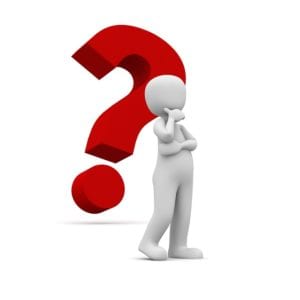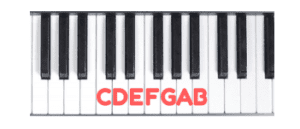When it comes to piano, you really can’t get more basic than the individual notes that each key represents. If you’ve taken any sort of lessons in the past, you probably know a bit about these piano notes. And even if you’ve never had a chance to have piano lessons, you might already be able to find middle C on your instrument.
That’s great, but let’s get real for a minute. Very few people seem to really be completely familiar with their piano. I can’t tell you how many times people have told me they “know the notes” but then can’t find them without counting or poking around with their fingers to locate the one they want. It’s kind of funny… and kind of sad.
Why You Need to Learn Piano Notes
If you want to play piano well, then learning piano notes will be the most important thing you can do. Why? Well, the individual piano keyboard notes form the basis of every single thing you do on your piano.
Do you want to fumble around each time you need to change chords, switch octaves or pick out a melody line? Do you really want to have to count on your fingers to figure out what comes three notes after G?
Of course you don’t, but for some reason even students with years of lessons seem to have a disconnect with this important topic. Far too many people (including myself in the past) rely on visual aids, or memorizing individual songs rather than working on the skills to play them more easily. Beginner piano lessons seem to frequently create this issue.
I think there’s one main reason behind this. Learning notes sounds too simple. It sounds too boring. It sounds like a waste of time.
Nothing could be farther from the truth! In my experience, my most successful students are the ones who take the time to learn the basics well. When you skimp on foundational skills, you steal from your future progress. Even easy piano songs for beginners will seem too overwhelming. And even the best online piano lessons can’t compensate for you if you don’t want to learn your notes.
Where to Begin?
Clearly, I have strong opinions about the importance of learning notes. So if you want to learn how to play piano, where should you begin? 
Begin by taking a deep breath and committing to getting this important knowledge down pat. Then relax, because this won’t be so bad – I promise. If you know the days of the week and the months of the year, you can learn the names of the notes on piano.
Understanding the White Keys
Here’s how this goes: There are multiple sets of the same exact keys all across your keyboard. There are only 12 actual unique notes – everything else is the same thing repeated at a higher or lower pitch.
Those sets of 12 repeating keys are named after letters. They run from A to G on white keys. Then they stop and start over. Every single white key on your keyboard is named after one of those 12 letters.
I get into this topic in-depth in Day 1 of my free 5-day workbook. It’s Day 1 because it is that important! Check it out. I take you through the process of memorizing the notes and share some practice resources to help you really grasp your newfound knowledge.
What About the Black Keys?
So far, I’ve only been talking about the white keys. But as you know, white keys aren’t the only ones on your piano. There are multiple sets of black keys, too.
The good news is that the black keys aren’t really different, they’re just positioned differently. And contrary to what you might think, they can really help simplify your efforts to learn all the piano note.
Musically speaking, black notes are considered sharps and flats. They actually can have two names at once because of this. But not to worry. This is not as complicated as it seems.
If you have a black key nestled between the C and D white keys, that black key can be correctly called C# and Db. The same principle holds true for any black key. When looking at it in relation to a white key on its left, it’s a sharp of the same name. If you’re viewing it in relation to the white key on it’s right, it’s a flat of the same name. Two names, one key – it’s all good.
Are We Missing Something?
One quick thing I need to address, since I get emails about this from time to time. Take a look at the message below:

If you, like Susan, noticed a few “missing” notes, good eye. But don’t worry, that doesn’t really matter for our purposes. Here’s how I answered Susan:

There’s some tricky music theory reasoning behind all of this. Let’s not get bogged down with useless info, and move on to more practical matters.
Orienting Yourself on Your Piano
So, how do you find your way around your piano? You’ll need to start with middle C.
Middle C is just about at the middle of all the keys on your instrument. Funny how that works, right? It is also the white key that appears to the left of a group of two black keys. If you have 88 keys, middle C is the 4th C from the left.
Most of the time, your right hand will play to the right of middle C and your left hand will play to its left. So each time you come to your piano, you can assume that you’re starting at middle C unless otherwise indicated. This really makes things simple.
How to Practice the Notes
Since we’ve been talking about C, let’s talk about how you can practice finding this piano note – and any others. But let me put your mind at ease first. You don’t need to know how to read music notes.
Start at middle C just like I’ve already described. Found it yet? Great. Now, let’s look at the 7 white keys to its right. In order, they are named D, E, F, G, A, and B.

That set of 8 white keys is what you need to practice. You need to learn their names, and here’s the important part: You need to be able to find them without counting up from middle C or any other piano notes. You should eventually be able to identify any of these notes by sight, without counting on your fingers or hesitating. It doesn’t really matter how many octaves on a piano there are – you just need to know the notes.
Easier said than done, right? Sure, but that doesn’t mean it’s impossible. With some simple exercises and a bit of practice, you can learn your piano notes. There are even ways to work on this when you’re away from your piano – and to learn piano online.
In my free 5-day workbook, I actually provide flash cards and an audio exercise specifically designed to help with this process. If you haven’t checked it out yet, I recommend you get started now. The notes you learn now are what will help you learn basic piano chords later.
Next Steps
Once you have a solid confidence in your knowledge of piano notes, you can move on to somewhat more glamorous activities! Your next steps depend on your long-term goals.
Are you trying to learn to sight read? If so, you will need to study some more music theory and learn to associate key names with notes on the treble and bass clefs. This is a bit challenging for most people, so you may need to hire a traditional piano teacher to help.
If you don’t care about sight reading, things become much easier. The more natural fit for you will be chord-based playing. That means learning how to read chord notation (super simple) and play chords based on what you see for each song. Fortunately, you don’t have to memorize chords in the same way that you did for notes! All you’ll need to know are the chord formulas that help you know which keys to press for each chord. Then you can learn how to improvise and spice things up.
Either way, the fact that you’ll already be learning piano notes will be a huge benefit going forward. Your traditional teacher will love you for already having taken this initiative. Or if you’re going the chord-based route, you’ll thank yourself later for how much easier this knowledge makes things.
Focusing on the Basics Isn’t Bad
I know it can be hard to force yourself to focus on the basics. But believe me when I say that your future piano studies will be hugely affected by your knowledge of the notes. Or your lack of knowledge.
Forewarned is forearmed, so you really have no excuse to skip this important step. I promise, when you feel comfortable finding your way around the keyboard, everything will come to you easier! It’s worth your time, especially if you want to learn to play piano by ear. So I hope you give this a shot!
All you need to do is sign up for my free 5-day workbook. I’ll email you a link to download this tried and tested resource on how to learn piano online. Then you can get to work on this all-important task of learning your piano’s notes!
